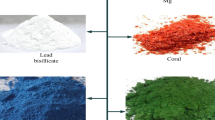Abstract
The basic trends in production of ceramic pigments based on silicates of different crystal structure are examined. The features of synthesis of the pigments and formation of chromophore phases are demonstrated. The use of natural silicate and aluminosilicate materials will allow expanding the raw materials base, reduce the temperature of synthesis, and produce pigments of a broader palette for decorating porcelain and faience articles.
Similar content being viewed by others
References
S. G. Tumanov, “New methods of synthesis and classification of pigments,” Steklo Keram., No. 6, 36–38 (1967).
L. Bragg and G. F. Claringbull, Crystal Structures of Minerals, G. Bell, London (1965).
A. S. Povarennykh, Crystal Chemical Classification of Mineral Species [in Russian], Naukova Dumka, Kiev (1966).
A. I. Platonov, The Nature of Coloring of Minerals [in Russian], Naukova Dumka, Kiev (1976).
N. M. Bobkova, Physical Chemistry of Silicates and High-Melting Compounds [in Russian], Vysheishaya Shk., Minsk (1985).
Wilhelm Eitel, Physical Chemistry of Silicates, University of Chicago Press, Chicago (1954).
I. V. Pishch and G. P. Ragunovich, “Synthesis of forsterite-containing pigments,” Steklo Keram., No. 6, 22–23 (1980).
A. I. Glebycheva and N. N. Kazakova, “Ceramic pigments based on cobalt-containing forsterite,” Steklo Keram., No. 2, 14 (1983).
V. M. Pogrebenkov and M. B. Sedel’nikova, “Ceramic pigments based on natural minerals,” Steklo Keram., No. 12, 10–12 (2002).
A. G. Betekhtin, Course in Mineralogy [in Russian], Gosgeologizdat, Moscow (1950).
G. N. Maslennikova, N. P. Fomina, and A. I. Glebycheva, “Study of the effect of substitution of SiO2 by SnO2, TiO2, or ZrO2 in willemite pigments,” Steklo Keram., No. 7, 28–30 (1976).
S. G. Tumanov, A. I. Glebycheva, and A. S. Bystrikov, “Production of dark blue willemite pigments of varied tonality,” Steklo Keram., No. 1, 35–38 (1964).
G. N. Maslennikova, N. P. Fomina, and A. I. Glebycheva, “Manganese-containing willemite pigments with mineralizer additives,” Steklo Keram., No. 10, 26–28 (1975).
S. G. Tumanov, Yu. F. Petrov, and A. S. Bystrikov, “Synthesis of ceramic pigments in the system R 2+3 R 3+2 (PO4)4,” Steklo Keram., No. 8, 31–32 (1968).
A. S. Bystrikov and Yu. F. Petrov, “Study of synthesis of a chromic pigment of the garnet type,” Steklo Keram., No. 8, 31–32 (1968).
I. V. Pishch, G. G. Skripko, Z. A. Drozdova, et al., “Synthesis of ceramic pigments from augite,” Steklo Keram., No. 9, 22 (1982).
I. V. Pishch and G. N. Maslennikova, Ceramic Pigments [in Russian], Vysheishaya Shk., Minsk (1987).
V. M. Pogrebenkov, M. B. Sedel’nikova, and V. I. Vereshchagin, “Ceramic pigments with diopside and anorthite structures based on wollastonite,” Steklo Keram., No. 2, 18–20 (1999).
I. V. Pishch, “Synthesis of diopside-containing pigments,” Steklo Keram., No. 9, 22 (1981).
M. B. Sedel’nikova and V. M. Pogrebenkov, “Effect of mineralizing additives on synthesis of ceramic pigments based on natural wollastonite,” Steklo Keram., No. 1, 21–23 (2006).
I. V. Pishch and G. B. Boronina, “Pigments based on anorthite,” Steklo Keram., No. 6, 24 (1982).
G. N. Maslennikova, V. P. Pyrkov, N. P. Fomina, and L. I. Cherepanina, “Pigments of mullite-like structure,” Steklo Keram., No. 1, 23–24 (1981).
I. V. Pishch, T. I. Rotman, and Z. I. Drozdova, “Ceramic pigments based on kaolin,” Steklo Keram., No. 7, 25–26 (1986).
I. V. Pishch, Silicate Ceramic Pigments, Author’s Abstract of Doctoral Thesis [in Russian], Khar’kov (1991).
Author information
Authors and Affiliations
Additional information
__________
Translated from Steklo i Keramika, No. 9, pp. 5–8, September, 2006.
Rights and permissions
About this article
Cite this article
Maslennikova, G.N., Pishch, I.V. & Radion, E.V. Current classification of ceramic silicate pigments (Review). Glass Ceram 63, 281–284 (2006). https://doi.org/10.1007/s10717-006-0101-1
Issue Date:
DOI: https://doi.org/10.1007/s10717-006-0101-1




